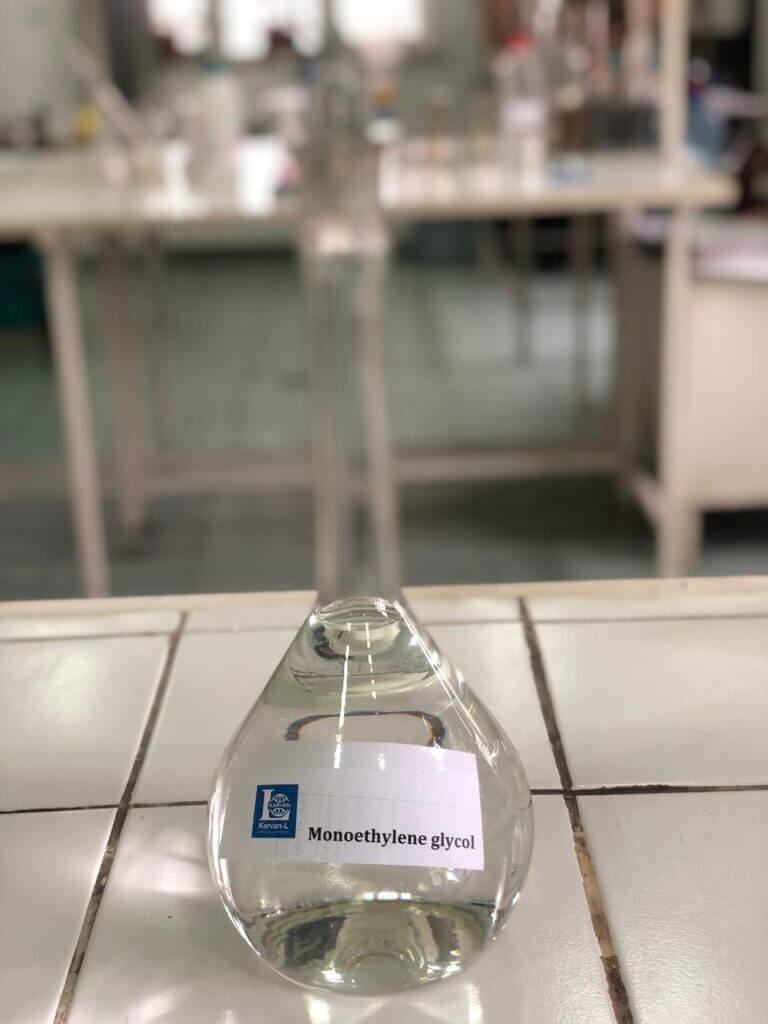Monoethylene glycol
Monoethylene glycol (MEG) or Ethylene glycol (glycol; 1,2dioxide ethane; ethanediol-1,2), HO—CH2—CH2—OH — simplest polyalcohol agent in treated form with transparently colorless liquid having slightly oily consistence. It is odorless and tastes sweet. MEG is applied in chemical, vehicle, aviation, electro technical, textile, and petrochemical industries. 4¬1 – 45% of the global ethylene glycol production is used for obtaining synthetic polyester fibers and films. One of the main application fields is production of unfreezing liquids, cool and heat carriers and it is a key matter used to produce different antifreezes, which are used in cooling systems of vehicle engines. Ethylene glycol is also applied in production of hydraulic and hardening compounds, polyurethanes, alkyd resin and etc.
Ethylene glycol (MEG, monoethylene glycol) – chemical reactive that is polyalcohol agent having syrup like liquid with sharp odor and slightly sweet taste. The matter is easily solved in ketones, water, acetone, and spirit, turpentine, moderately in diethyl ester, toluol and benzol. Vegetation and animal oils are poorly solve in it and such matters as paraffin, rubber, and mineral oil do not solve altogether. Heat forms when it interacts with water and by that ethylene glycol volume diminishes.
Main physical – chemical MEG features:
- Molar mass – 62,068 g/mol;
- Optical deflection coefficient – 1,4318;
- Ignition temperature – 124°С (upper threshold) and 112°С (lower threshold);
- Self – ignition temperature – 380 °С;
- Freezing temperature ( hundred percent glycol) – 22 °С;
- Boiling temperature – 197,3 °С;
- Viscosity – 11,113 g/sm3.
Ethylene glycol application
Ethylene glycol is always in great demand as its usage in the national economy is quite widespread. Main fields of its usage is as follows:
- Production of heat carriers and coolants.
- Production of various chemical reagents to make synthetic wax, polyesters and other products.
- Production of plastic bottles.
- Plastic bottles are made of polyethylene terephthalate, which is formed by banding of such compounds as ethylene glycol, terephthalate acid and catalyst.
- Chemical reagent to solve coloring matters.
- Synthetic fiber production.
- Hydraulic liquid production.
- Solvents primarily formed by ethylene glycol are applied to lubricate drives and other components of hydraulic equipment – metallurgical and metal cutting machinery, excavators, combines, vehicle and aviation machinery.
- Drugs production.
Ethylene glycol is used to obtain many valuable chemical products, which are used in the drugs and medical preparations.
Notably, toxicity of this matter is not considerable and inhaling its vapors in a short while does not pose serious hazard to the health. However, high vapor concentration may call forth weakness, irritation of mucous eye and respiratory tracts and therefore this matter should be handled with utmost precaution and accuracy.
Application
Thanks to its cheapness, ethylene glycol has wide spread usage in machinery.
- As a component of vehicle antifreezes and break liquids that make up 60% of its total consumption.
- Heat carrier as a solvent in vehicles.
- Liquid cooling system of computers.
- Production of cellophane, polyurethane and some other products.
- As a solvent of paint matters.
- As a high temperature solvent.

